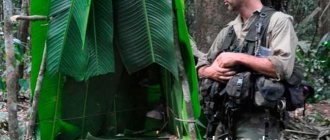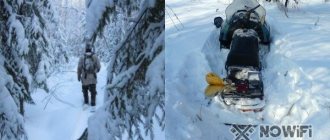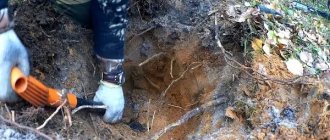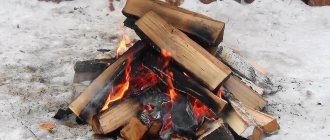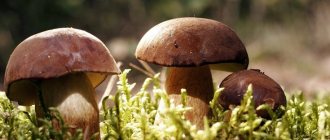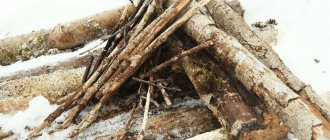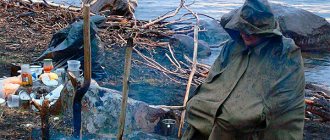What to take with you to the forest
Recommended items do not need to be collected every time. It’s enough to pack them in a small pouch or bag before your first hike, and then take this set with you all the time. What you need to pack before your forest hike:
- Knife. Such a thing may be needed in various situations: from cooking to building shelters. In this case, you can choose any type of knife: regular or Swiss.
- Compass. You must have the device with you. In the wild, you can't rely on electronics, and a compass will help you find your way.
- Means of igniting fire. These include matches, lighters (preferably bright colors), flint, and active kindling.
- Rescue blanket or 2 garbage bags of 240 liters each. Such a thing will not take up much space, but it can be useful for creating a raincoat or even a tent.
- Flashlight. It will definitely come in handy at night. Using a flashlight on your phone will quickly drain the battery.
- Rope. It is better to prepare 5-7 meters of rope.
- Marker, pencil and bright office stickers. It is necessary to leave marks along the traversed path for the search and rescue team.
- Two chocolate bars. Snickers bars are considered an excellent source of calories.
- Flask, plastic bottle. The containers are filled with water, which is vital for humans. In addition, you can make fish traps from a plastic bottle.
Note!
So that you don’t have to think about how to survive in the forest without everything, you should prepare at least a minimum rescue kit before going on a trip. The collected items will help a lost tourist survive until help arrives.
The required set can be assembled once and then carried with you all the time
Essay What can you do in the forest in the summer?
Summer is the most wonderful time of the year. All nature blooms, grows and bears fruit at this time. Insects, birds and animals are busy with their own affairs all day long. Many people stock up for the winter in order to comfortably survive the cold.
What can a person do in a summer forest? Walk and enjoy the warm air, saturated with the smell of flowers, tree resin, and summer herbs.
Although you can do useful things, for example, pick berries for jam. Fragrant strawberries and wild strawberries beckon with their red berries. In the morning hours you can stock up on medicinal herbs. Also, having a camera in your hands, you can take a series of pictures. After all, in winter, photographs with forest landscapes will warm your soul with warm memories. And it will be possible to organize an exhibition of works at school dedicated to the summer forest.
When in the forest in summer, you should walk carefully and quietly. After all, in the bushes, grass and on the branches of trees there are many nests in which the offspring are located. These can be bird chicks or small bunnies, squirrels, hedgehogs. Under no circumstances should you take them home with you. This will be disastrous; the babies will not survive in captivity. But you can hang several feeders on branches in the forest; the food won’t hurt. For animals, you can place pieces of salt on the stones; they love it very much.
What else can you do in the summer forest? If this forest is located near people’s homes, then it is worth inspecting for the presence of garbage. And if this is observed, then it is worth cleaning the area. To carry out the cleaning, you should gather your friends, then more territory will be cleaned. A clean forest will repay you with a large harvest of berries and mushrooms, and the singing of birds.
If possible, go for walks in the forest as often as possible in the summer. The forest is wild nature that will not bring you anything bad. A walk through the forest is a charge of good mood and a lot of positive emotions.
Psychology of a lost person
When a person finds himself in a difficult situation in the wild, his mind is overwhelmed by emotions and panic. Thinking becomes not rational. In the field of psychology, there is even a term that describes this state - “forest shock.”
The scientific explanation for this definition is that a person’s actual environment does not coincide with his cognitive representation of the surrounding area. Due to such distortions, the state of a lost person goes through five stages:
- Negation. The person continues to believe that he is moving in the right direction.
- Anger, awareness, panic. An understanding of the current situation comes. Panic attacks occur, which leads to senseless and even dangerous actions.
- Planning, delusion. Exhaustion or injury sooner or later lead to the fading of emotions. A person develops a false opinion about the correctness of the further path.
- Disappointment, fading. After unsuccessful attempts to find a familiar or crowded area, a person stops making physical and mental efforts.
- Salvation or death. This stage, as a rule, does not depend on the person himself. If rescue does not arrive, he will die.
It is a person’s panic state that can lead to this result. Therefore, the most important rule for survival in the forest is to overcome panic.
A lost person immediately has the desire to run in all directions at once. However, the best solution would be for him to stop, take a breath and ask himself questions: “Where was I last seen?”, “Will they be looking for me?”, “What landmarks did I see on my way?”
Important!
If panic begins again, it is necessary to distract yourself so that this state does not confuse you. To do this, you can do anything, for example, sing, read poetry, pray.
A lost person goes through five stages
Lilies of the valley
Many people, for commercial purposes or simply for aesthetics, go into the forests to pick a bouquet of lilies of the valley. However, few people know that this flower is listed in the Red Book in many regions of our country.
For illegal destruction of a plant there may be a fine of around 300 rubles. If caught doing this again, the fine is doubled.
Moreover, by picking the most beautiful flowers, people disrupt the process of natural selection. The best specimens slowly wither in their homes, while the weakest barely grow in the forest.
It is because of this that there is a danger that they may disappear altogether.
This is interesting: DIY kayak
Please note that this beautiful flower is dangerous. It contains poison along the entire length from the roots to the stems. The substance has an extremely negative effect on the functioning of the cardiovascular system. Moreover, if a cat or dog tastes it, they will die. However, the pungent smell repels animals, so there are no cases of lily of the valley poisoning in wildlife.
Forests are one of the most important ecosystems on Earth. They are home to 80% of all plants, animals, fungi, bacteria and other living things.
Almost a quarter of the world's people depend directly on forests for their livelihoods. Forests regulate the climate, maintain the fullness and purity of water bodies, capture dust particles and pollutants from the air, ensure the formation and fertility of soils, and improve the physical and mental health of people.
Forest ecosystems provide these vital services equally to everyone, regardless of citizenship or income. Every day, in addition to clean water, air and food, we use other resources that forests provide us: building materials, paper products, medicinal and food plants.
Every year the planet loses 7.3 million hectares of forests - almost twice the area of Denmark or the Netherlands. The rate of forest loss is 27 football fields per minute.
Global forest area continues to decline in all countries of the world, which can be seen even in real-time satellite images, and Russia is no exception. If we continue to lose forests at the current rate, in 80 years there will simply be no forests left on our planet.
By changing your attitude towards the problem and becoming a little more attentive to your habits, everyone can make a significant contribution to the conservation of forests.
What to do to avoid dying
Fans of adventure and tourism should know the basics of survival not only in the forest, but also in the jungle. These are two completely different areas, but the recommendations on how to behave in the event of a loss of direction are largely similar. Survival in the jungle and forest requires following certain rules.
Is there a connection
First of all, you need to save the battery power of your mobile device. Therefore, if there is a connection, it is better to write SMS. The message should be sent to those who are able to help and contain brief but as complete information as possible about the location.
Most often, there is no connection in the forest, but you can always contact the rescue service by calling 112. If you manage to get in touch with rescuers, you must clearly answer all questions, and also formulate your answers as briefly as possible.
Ambient sounds
Mechanical extraneous sounds will help you get out of the thicket of the forest. These include noise from trains or cars, and even people's voices can be heard up to 1 km away.
In order not to forget where the sound is heard from, it is recommended to make a sound azimuth. To do this, a person must take a stick and point it in the direction of the noise. Then the movement begins in azimuth.
The sound of a train in the forest will help you get your bearings
Orientation in space
Survival skills in the wild are largely based on the ability to navigate in space not only by compass, but also by natural signs.
Using a compass
This device will help determine the cardinal directions, but you need to decide in which direction to move. After all, following exactly north can lead even further into the forest.
In this case, it is convenient to use a navigator, but not everyone has this opportunity. Therefore, you should pay attention to surrounding signs.
Without a compass
Terrain orientation can be carried out without a compass using the following methods:
By apparent sunset and sunrise (west, east)
There are periods during the day when the sky is at its most contrasting. It is better to determine the cardinal directions at this time. In this case, you need to go out into the open.
By clock and sun (north, south)
The method of orientation using a watch is not the most accurate, but it will nevertheless help to approximately determine the cardinal directions. To do this, you need to point the hour hand towards the sun. Then place a thin stick on the clock between the hand and the true noon mark. The resulting angle bisector will indicate the south direction.
The cardinal directions can be determined by the clock
By quarter pillars
At the moment, poles dividing the forests into blocks are rarely found in the forest. But if you manage to stumble upon such a sign, it is important to understand that the line between the smallest numbers points to the north, respectively, the south is in the opposite direction, and it can be determined using the largest numbers.
By the stars and the moon
Objects in the night sky are important landmarks for a lost person. However, only experienced tourists can navigate by the stars and the moon.
There is a known method for finding the north direction using the North Star, and in the southern hemisphere they find the south using the Southern Cross constellation. Orientation to the Moon is carried out in the same way as to the Sun. Only in this case it is necessary to look for the angle between the small clock hand pointing to the moon and the mark indicating midnight.
Through the trees
On the southern side, trees dry out faster after precipitation and have a denser crown than on the opposite side. You can also find an anthill near the trees, which are located in the south.
For your information!
The north side is located where the darker color of the tree bark is. It is noted that mosses on the bark also indicate north.
The anthill near the tree is located on the south side
According to local characteristics
Large objects on the ground are considered the best and most reliable landmarks with which to reach people. For example, rivers, railways and dirt roads (even abandoned ones), autonomous power line systems.
Moving in the direction of the location of these objects, you can go to the nearest populated area. At the same time, you should not stray too far from the landmarks.
Using special applications on your smartphone
When planning a trip to the forest, you should install and test applications on your phone in advance, including a compass, navigator and map. To use this method, you need, firstly, to have sufficient battery power on your smartphone, and, secondly, to be confident in the accuracy of the application.
Walking in circles
Most people have a shorter right stride than their left. And this fact has been scientifically proven.
A lost tourist seems to be heading in the right direction. However, in fact it makes a circle and at a certain moment will return to its original place. Therefore, it is not recommended to move without choosing a specific landmark.
The reason for the circular motion is the lack of a clear visual reference
Don't go fast
Many believe that it is worth speeding up your pace to get out of an unfamiliar area before dark. However, rash and hasty decisions can only aggravate the situation and drag you even deeper into the forest.
In addition, a lot of physical energy is spent on fast movement. Attentiveness may also decrease, which can lead to injury.
Note!
For an untrained person who does not have a load, it is recommended to move at a speed of 1.5 km/h. A physically developed person can move at higher speeds, up to 4 km/h.
Halt device
Every hour a tourist must stop and take a break. 5-10 minutes are enough to catch your breath and check the route.
In addition, large breaks should be organized every 5 hours. The duration of such a stop is at least one hour or more. The main thing is to have a snack and gain strength to continue the journey.
It is very important to choose a safe place. It is worth making sure that there are no dangerous insects living nearby, and that there are no rotten stumps in which snakes can live.
If possible, rest stops are arranged at higher elevations, because in these places it is more windy, which means there are fewer insects that can bite. If the movement is carried out on a flat surface, and there is no hill in the area, then you should find an open area for a rest. In the right terrain, it is most likely that a distress signal will be noticed.
It is better to choose a place to rest on hills away from stumps
Arrangement of overnight accommodation and shelter
Despite the fact that in summer the temperature is quite high during the day, at night you will not be able to spend the night without an organized sleeping place and a fire.
To successfully arrange an overnight stay in the forest, you should adhere to the following rules:
- You should think about arranging your overnight stay before dark;
- for a sleeping place, choose an area sheltered from the wind with dry soil;
- You can’t lay down on the ground, because this way a person will quickly freeze, so build either a flooring from thick branches, logs and leaves, or a hammock;
- spruce and pine branches are used for bedding, thanks to which mosquitoes will not bother;
- the bed should be positioned parallel to the fire so that the body is heated evenly;
- Before going to bed, it is necessary to prepare in advance a sufficient amount of firewood to support the fire.
As the day draws to a close, it's worth considering a shelter to keep you safe and warm during the night. The shelter can be built in the form of a hut.
The first step is to build a reliable support for the hut from dry branches folded into a cone. The top of the support is covered with spruce or fir spruce branches, straw, grass or even garbage bags, which will serve as a roof. The hut should be located with its open parts facing the dense forest, and the side parts (roof) should be protected from the wind.
Shelter in the forest is necessary to ensure safety and keep warm
Making a fire
If you don't have any matches in stock, you can use other methods of starting a fire. However, in this case, it is much more difficult to achieve the appearance of fire.
Instructions for starting a fire without using matches include two methods:
- Using glass. If you have glasses with magnifying glasses, then you need to direct the light beam through them onto the collected substrate of moss and grass.
- By frictional force. The moss is laid out on a dry log, on which a notch is first made. Active rotation of a thin stick occurs between the collected moss.
The second method takes a lot of time, as a result of which calluses and wounds may appear on the hands. To avoid this, you need to protect your palms by wrapping them with cloth.
A fire is necessary not only to keep warm, but also to scare away wild animals, as well as for cooking.
Important!
The thicker the branches for the fire, the longer it will burn. Therefore, it is advisable to find a thick, dry log. But we must not forget that a fire that is too large can get out of control, which is very dangerous in the forest.
Tags and notes at the overnight stay
From the beginning of any movement, the lost tourist must leave notes indicating his full name, date and time of departure. The direction of the path can be indicated using homemade marks on the ground. These actions will facilitate and speed up the search for rescuers.
What useful things can you do in the forest?
What is a forest, and why is it vital for humanity? How to protect the forest from fire? How should you change your consumption habits to save forests? How to deal with corrupt officials and illegal logging? Details in our material.
Why do we need a forest?
Forests are one of the most important ecosystems on Earth. They are home to 80% of all plants, animals, fungi, bacteria and other living things. Almost a quarter of the world's people depend directly on forests for their livelihoods. Forests regulate the climate, maintain the fullness and purity of water bodies, capture dust particles and pollutants from the air, ensure the formation and fertility of soils, and improve the physical and mental health of people.
Forest ecosystems provide these vital services equally to everyone, regardless of citizenship or income. Every day, in addition to clean water, air and food, we use other resources that forests provide us: building materials, paper products, medicinal and food plants. Every year the planet loses 7.3 million hectares of forests - almost twice the area of Denmark or the Netherlands. The rate of forest loss is 27 football fields per minute.
Global forest area continues to decline in all countries of the world, which can be seen even in real-time satellite images, and Russia is no exception. If we continue to lose forests at the current rate, in 80 years there will simply be no forests left on our planet.
By changing your attitude towards the problem and becoming a little more attentive to your habits, everyone can make a significant contribution to the conservation of forests.
Protect the forest from fire
One of the main problems of preserving and increasing the forest fund, including in Russia, is not deforestation at all, but annual fires, which in most cases arise due to negligence and barbaric attitude towards nature. According to various sources, from 1.5 to 15 million hectares of forest burn in Russia every year. According to statistics from Rosleskhoz, 3.2 million hectares were damaged by fire in 2021. Greenpeace and WWF, which focus primarily on the analysis of satellite images, claim 14.6 million hectares and that 2018 was the third largest in the 21st century in the area of forest fires in Russia.
Greenpeace Russia gives some invaluable advice on how to avoid fire hazards in the forest.
Firstly, never set fire to dry grass anywhere.
. The vast majority of spring forest and peat fires occur as a result of burning dry grass.
Secondly, do not light fires unnecessarily
. If you make a fire, do it only on mineral soil, where there is no danger that peat or forest litter that has accumulated between the stones will begin to smolder from the fire. The fire should not be left unattended and must be thoroughly extinguished before leaving.
Thirdly,
and similar objects
to fall on the ground . In summer, in a dry forest, especially on a peat bog, you need to behave as if you were in a powder warehouse.
Fourthly, if a fire is detected in the forest
(an abandoned fire, smoldering moss or litter, burning grass)
try to extinguish it on your own,
and if this does not work, report it to the fire department or the nearest forestry department as soon as possible by calling 8-800-100-94-00 (this is the all-Russian forest guard telephone number), 101 or 112.
In addition, you can always join the community of volunteer forest firefighters in Russia or support them financially.
Reconsider your consumption habits
- Use paper wisely
Every year, 4 billion trees are cut down around the world to make paper. The average lifespan of one sheet is no more than 19 minutes, and more than a third of all household waste is paper. Greenhouse gas emissions associated with paper production are three times greater than those of the entire world's aviation industry. The pulp and paper industry ranks first in the world in water consumption and fifth in electricity consumption. The less paper we use, the more resources we save, which means less damage to the environment.
Participate in the “Add Green!” flash mob Learn how to save paper and encourage your friends to use it wisely.
- Collect and recycle waste paper
One ton of recycled paper prevents the cutting down of 10–17 trees, saves 20 thousand liters of clean water and 1000 kilowatts of electricity.
- Use certified paper products
As a consumer, you can stimulate demand for products produced with minimal negative impact on the environment. By purchasing products with the logos of the Forest Stewardship Council (FSC) and the National Forest Certification System PEFC RUSSIA, you guarantee the choice of goods from materials obtained legally, and support companies that strive to produce wood sustainably - with minimal harm to nature and respecting the rights of their workers and indigenous peoples.
- Eat more plant-based foods
Almost a third of the planet's ice-free surface is pasture for livestock, and 30% of the available arable land is used to grow animal feed. The global demand for meat is constantly growing, but the space for raising livestock is not. Thus, livestock farming has become one of the main causes of deforestation in the Amazon: about 70% of deforestation of local tropical forests occurs for livestock breeding.
If people eat more plant-based foods, the demand for meat will fall and it will not be as profitable to produce it. Businesses will redirect their investments to other sectors of the economy, and lands that were previously occupied by pastures and livestock farms will be overgrown with forests or used for arable land and vegetable gardens.
What to eat and drink
According to the guide on how to survive in the jungle or forest, the first task is to get water. You can get it from any body of water, but it is not immediately suitable for drinking, since river water may contain bacteria and infections. If possible, water is pre-boiled with the addition of charcoal or activated carbon.
If a stream is not found, then drinking water can be collected from the leaves of trees. To do this, in the morning a plastic bag is placed on a tree branch with large leaves. After a few hours, you can see that the bag is filling with liquid.
After the collected provisions have run out, you need to independently look for food in the wild. It is very important to remember that you can only eat plants that you are familiar with. Experiments can lead to poisoning, so if familiar berries are not found, it is better to fast for several days.
In addition to berries, there are mushrooms in the forest. Nothing compares to them in nutritional value. However, it is worth pre-cooking them for a long time.
It is also possible to cook protein foods in the forest. This includes found eggs of birds, earthworms, frogs and even rodents, which need to be fried over a fire. Plus, you can catch fish and also fry or cook fish soup from it.
You can get food in the forest in different ways
Homemade cooking utensils
If the task is to boil or collect water, you cannot do without dishes. The most convenient and successful option is to find some kind of container, even a tin can left by tourists will do. But in the wild, you can even make dishes with your own hands.
To make the container, you will need to prepare a thick piece of tree bark. Birch bark cut into a rectangular or oval shape is best. It is folded, and homemade clothespins made from branches are used to hold the structure.
Fact!
Homemade utensils made from birch bark should not come into contact with open fire. Therefore, boiling water should only be done over coals.
Homemade water filter
As mentioned earlier, water from found reservoirs can only harm the health of tourists, therefore, in addition to boiling, the water must go through filtration. There is a way to make a simple filter using a sock.
You need to take a clean sock and put three cleaning layers in it:
- charcoal,
- sand,
- grass.
The top grass layer leaves large particles, then the water continues to be filtered by sand, and thanks to coal, harmful impurities are absorbed. When filling the sock with liquid, you should hang it and wait until the water passes through all the layers and drains.
Forest first aid kit for survival
When going on any trip, it is recommended to take a first aid kit with you. The minimum kit should include antiseptics, drugs to reduce body temperature, painkillers, a tourniquet or bandages.
In extreme survival conditions, without a first aid kit, a person risks complicating his health when he gets cold or gets an infection in his body. However, you can use natural ingredients for a specific disease.
| Situation | Natural component | Usage |
| Pain and upset stomach | Oak bark | Brew tea from the bark |
| Charcoal | Take orally | |
| Increased body temperature and fever | willow bark | Chew |
| Oak bark | Brew tea from the bark | |
| Insect bites | Dandelion, plantain | Treat the wound with plant juice |
| Snake bite | Series | Apply the plant to the wound after sucking out the poison |
| Wounds and ulcers on the skin | Oak bark, conifer resin | Apply to the site of skin damage |
| blueberry leaves | Boil and apply to purulent wounds | |
| St. John's wort | Brew tea and take orally | |
| Inflammatory processes | Lingonberry leaves, chamomile, St. John's wort, blueberry, lichen | Boil and take orally |
In the absence of medical assistance, “passing remedies” will help
Dangerous plants
There are no less poisonous plants in the forest than in the jungle. Due to human carelessness, poisoning and damage to all organs can occur. Therefore, when you come across an unfamiliar shrub, you need to make sure that it does not have bright elements or a pungent odor.
Dangerous forest plants include:
- Wolfweed is a low shrub with bright red berries;
- Spotted hemlock - a characteristic feature of the plant is small white flowers and a strong unpleasant odor, reminiscent of the smell of mice;
- Crow's Eye is a well-known plant with a yellow-green flower followed by a large black berry;
- Marsh wild rosemary is dangerous if its toxic fumes are inhaled; it has oblong glossy leaves and grows in large thickets in taiga swamps.
All plants that are dangerous to human health are very difficult to remember. In this regard, it is better not to eat or even touch any plant unknown to tourists, but to avoid it.
General points
Let's start with general rules that should be known to everyone. Most likely, you have already seen all this on the “Take care of nature” posters.
1. First of all, you should know that you should not make too loud sounds. Small animals are frightened by this and most often quickly leave their usual habitats. Because of this, they often forget about their young. In addition, noise may, on the contrary, attract predatory animals.
2. You cannot enter the closed territory of protected areas. Here, even without the “Take care of nature” poster, everything is clear: protected areas were created so that people could not interfere with them.
3. It is very important to take all your garbage with you. You can even do it from someone else if you want to help nature. You need to leave everything behind as if you weren’t there. Remember that many materials, especially plastic, do not biodegrade at all, which means they can sit in the ground almost forever.
4. You should also not experiment with unknown berries, mushrooms or plants. Maybe nothing bad will happen, but if it suddenly becomes bad, timely help will definitely not be provided.
5. You should also not be too active and try to pet wild animals. They are not used to this, so they may perceive it as aggression.
6. Do not park your car in areas not designated for this purpose.
This is interesting: How to knit a fishing net with your own hands
7. Do not destroy rare species of plants and animals.
Below we will take a closer look at the main points from this list.
How to behave when meeting wild animals
Many are sure that in the wild you can meet large predatory animals: a wolf, a bear or a boar. However, when moving noisily through the forest, the likelihood of an attack by wild animals is extremely low.
The greatest danger is posed by rabid animals, such as foxes or raccoons. If the animal growls, yelps and it is clear that saliva is dripping from its mouth, then this is rabies, which is no less dangerous for humans. In such cases, you will have to protect yourself with any sharp or heavy objects and kill the sick animal.
Don't run away from the beast and don't turn your back
How to identify yourself so that you can be found from the air
Helicopters are used to search for a tourist who is lost in the forest. Therefore, you need to be prepared to designate your location so that it is visible from above.
You can build a large fire in an open space. Rescuers will be attracted by both the smoke and the glow of the fire. If you hear the sound of an approaching helicopter, you should prepare a flashlight or smartphone with the light on. Also a noticeable symbol is the inscription SOS trampled on the ground or snow.
Any person who goes into the forest can stray from the intended tourist path, fall behind the group, or go deep into the forest. Survival skills and even a superficial familiarity with them will help you survive in the wild until rescuers arrive, and sometimes you can get out of the forest on your own.
Was this information useful to you? Share in the comments!
